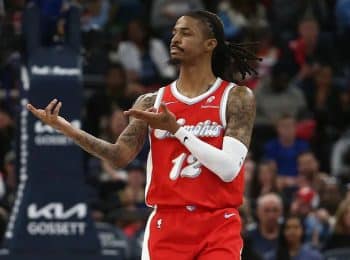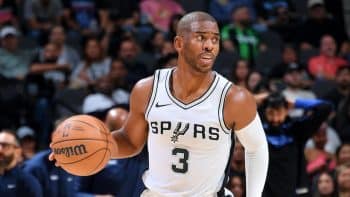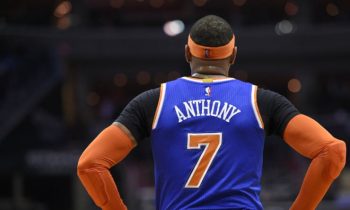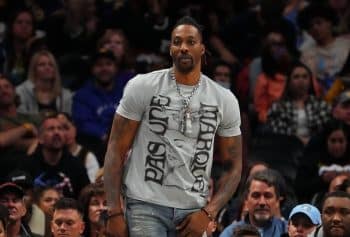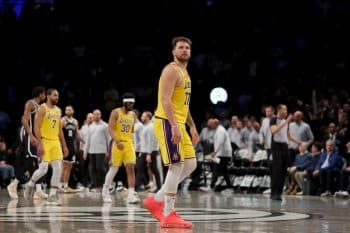NBA
NBA Saturday: Anthony Davis Stands to Improve Under Alvin Gentry
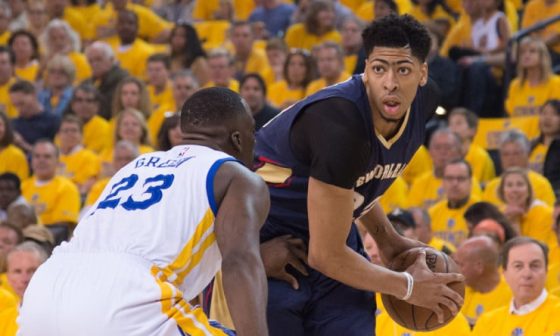
When the New Orleans Pelicans fired Monty Williams on May 12, there was some bewilderment among fans and people around the league. The Pelicans made it to the postseason for the first time since 2011, winning a season-saving game in the regular season finale against the San Antonio Spurs to knock the Oklahoma City Thunder out of the eighth and final playoff spot in the Western Conference. The Pelicans were eventually swept by the Golden State Warriors, but those same Warriors were coming off a historically great regular season and are now just two wins away from hoisting the Larry O’Brien trophy.
Shortly after the news of the firing broke, names of potential replacements started appearing. Tom Thibodeau, Jeff Van Gundy and Alvin Gentry were the three names mentioned most frequently. Thibodeau, known as a defensive guru, certainly made sense considering the Pelicans were ranked 22nd in defensive efficiency, despite having Anthony Davis and Ömer Aşık protecting the paint. Nevertheless, the Pelicans eventually hired Gentry, who is known for pushing the pace on offense. New Orleans ranked 27th in pace this season, so it is clear that the Pelicans’ front office prioritized offensive improvement over defensive improvement, despite finishing ninth in offensive efficiency this season. So now the question is, what happens when you add an offensive-minded coach to a team featuring a superstar talent like Anthony Davis?
At age 22, Davis is arguably a top-three and certainly a top-five player in the NBA. This season, Davis averaged 24.4 points, 10.2 rebounds, 2.2 assists, 1.5 steals and 2.9 blocks, while shooting 53.5 percent from the field. He also had an extremely impressive 30.8 Player Efficiency Rating and 59.1 True Shooting percentage.
As good as Davis was, however, he could have done even more, as Gentry reportedly pointed out in his interview. On the season, Davis had a 27.8 usage rating, according to Basketball-Reference. This is a high number, but it doesn’t accurately indicate how often or effectively Davis was being used by Williams. To illustrate this point, consider that Blake Griffin of the Los Angeles Clippers had a 28.4 usage rating, but tallied 5.3 assists per game this season compared to just 2.2 for Davis).
Part of this can be explained by looking to Nylon Calculus’ True Usage metric, which is “an estimate of the percentage of offensive possessions on which a player contributes to the end result while he is on the floor. ‘Contributing’ is defined as a scoring attempt, turnover or potential assist.” This season, Griffin had a 44.9 True Usage rating, whereas Davis had a 36.8 rating. As we can see, there is a wider gap between each player’s True Usage ratings, as opposed to their traditional usage percentage. The reason for this, in part, is that Griffin is asked to be more of a play-maker than Davis has been, so his impact on his team’s offense is larger and more diversified than Davis’. This is reflected even further by each player’s Assist Usage numbers, which is defined as the percentage of possessions a player sets a teammate up with a scoring chance, generating a potential assist, as measured by NBA.com’s SportVU tracking data.
Griffin has a healthy Assist Usage rating of 13.7, whereas Davis’ is just 6.8. Again, what we see is a big disparity in the way each player was being used within their respective team’s offense. It should be recognized that Griffin is probably the best play-making power forward in the NBA due to his ability to handle the ball in transition and his passing ability. However, Davis is a solid ball-handler and passer in his own right and should be put in a position where he is looking to set up a teammate for an open shot just as often as he is looking for his own. If he can do that, his impact on New Orleans’ offense will increase significantly, which is a scary thought for the rest of the NBA.
This is where Gentry comes in.
Gentry started his NBA coaching career with the San Antonio Spurs as an assistant to Larry Brown. Also on that staff were Gregg Popovich and R.C. Buford. Gentry would go on to work with several different teams until being hired as the head coach of the Los Angeles Clippers in 2001. Gentry was fired in his third season with the Clippers, and then joined Mike D’Antoni for five seasons in Phoenix. In 2009, Gentry was named head coach of the Suns after Terry Porter was fired. In his first full season as head coach of the Suns, he led Phoenix to a 54-win season and an appearance in the Western Conference Finals. In 2013, he left Phoenix and was hired as Associate head coach to Doc Rivers with the Clippers, but was wooed away by Steve Kerr and the Golden State Warriors after one season in Los Angeles.
The first thing that stands out about Gentry’s coaching experience is his time in Phoenix. Gentry had a hand in running the mid-2000 Phoenix Suns’ “Seven Seconds or Less” offense, which changed the way modern NBA teams run their respective offenses. The traditional notions of each individual position were cast aside, quick shots were emphasized, floor spacing became a necessity and the high pick and roll became a fixture in the Suns’ offense. These principles have been adopted across the NBA ever since, and part of that evolution is credited to Gentry.
With Gentry now in charge, we are sure to see the Pelicans’ pace increase significantly next season. In 2009, with Gentry as head coach, the Suns had the fourth highest pace in the league, and the number one offense, which scored a blistering 112.7 points per 100 possessions (which was 3.2 more points per 100 possessions over the second best offensive team that season, the Orlando Magic).
In his one season with the Clippers, he helped Doc Rivers implement an offensive system that emphasized getting out in transition and player movement in the half court. That Clippers team had the seventh highest pace in the league, and the most efficient offense, scoring 109.4 points per 100 possessions.
This season, with Steve Kerr, Gentry has helped Golden State develop into the fastest, and second most efficient offensive team in the league. The only team that was more efficient offensively was, you guessed it, the Los Angeles Clippers, who continued to benefit from Gentry’s input from the prior season. In comparison, the Pelicans were the 27th slowest team in the league this season, according to NBA.com, which will certainly change moving forward under Gentry.
But picking up the pace isn’t all it will take to make Davis even more lethal than he already is. More possessions means more touches, but Gentry knows that Davis needs to be used differently as well.
Give Williams credit for using Davis so often in the pick and roll this last season. In pick and roll sets, Davis led all players in total points scored, he scored 1.16 points per possession (84th percentile) and shot 57.2 percent. We should see a lot of the same here with Gentry running things, but now we will likely see Davis as more than just a scoring threat. Consider that Draymond Green, who has played at power forward all season for the Warriors, saw his assist numbers almost double since last season. This has a lot to do with a bigger role and more minutes, but it also is a result of the motion-based offense the Warriors run. When Green receives the ball rolling to the rim, he generally has multiple options, including attacking the rim, dumping it off to someone cutting to the basket, or finding an open shooter for a three-pointer. Now imagine putting Davis in that position with a similarly designed offense, and all of the sudden he is in a position to be an elite scorer and dangerous play-maker.
But where Williams deserves credit for putting Davis in the pick and roll, he also should be faulted for not emphasizing getting Davis out in transition more often. That is something that Gentry will certainly look to change.
Among players that scored two or more points per game in transition this season, Davis was among the most effective. In transition, Davis averaged 1.56 points per possession (98.4 percentile), utilizing his incredible length, athleticism and skill to score easy baskets. The problem is that Davis only executed plays in transition 8.2 percent of the time. In comparison, Blake Griffin got out in transition at a 13.4 percent rate, scoring 1.21 points per possession. In addition, Draymond Green got out in transition at an 18.2 percent rate, though he only scored 1.14 points per possession. People often talk about how big of a weapon it is to have a power forward like Griffin or Green, who can grab a defensive rebound and run a fast break. Well, Davis is even more effective than either Griffin or Green in transition and it is something we should see more of next season.
The difference, of course, is that Golden State has the defensive skill to get stops and get out in transition frequently. That will be the challenge for Gentry. He will need to help turn the Pelicans into a team that can get defensive stops and fly out in transition to take advantage of Davis’ physical talents and scoring efficiency in the open court.
“We like to shoot quick shots in transition because we’re very capable of making them,” Gentry explained to Ben Golliver of SI.com. “Those are good shots. They keep pressure on the defense. And we want to keep the defense on its heels by always staying in attack mode. That’s been our philosophy here.”
That is what Gentry will look to create in New Orleans. It won’t happen overnight. You can play at a fast pace, but that doesn’t mean you will be an effective team (just ask the Philadelphia 76ers). The issue with all of this, of course, is going to be personnel. Gentry’s teams have had Steve Nash, Chris Paul and Stephen Curry running the point guard position with a lot of talent surrounding them. Is Jrue Holiday, Tyreke Evans, Eric Gordon, Ryan Anderson and whoever else the Pelicans acquire this offseason enough to recreate the offensive synergy that Gentry has had in the past? Well, that won’t be clear until the Pelicans start assembling next season’s roster and we have a better sense of who Davis will be surrounded by.
What we do know is that Gentry is going to look to work his offense through Davis, which will likely turn him into an even more productive player, which seems impossible at this point considering how dominant he already is. But the truth is that Davis was featured in Pelicans offense a lot this season, but he wasn’t its driving force. Consider that Davis only touched the ball 58.9 times per game this season, whereas a player like Griffin touched it 81.9 times, despite playing with a ball-dominant guard in Chris Paul and playing roughly the same amount of minutes per game as Davis.
All of this is to say that Davis put up monster numbers even when he wasn’t being used as frequently or efficiently as he could have been. With Gentry running the show now, we should expect to see Davis become the engine that powers the Pelican’s offense, both as a scorer and as a play-maker. Considering how much Davis has developed in just these last few seasons and how much Gentry has impacted the offensive efficiency of the teams he has coached over the last few years, the rest of the league should be very concerned. And none of this even contemplates what will happen if the Pelicans surround Davis with some effective teammates that can spread the court, or if Davis develops a three-point shot. When that happens, there won’t be much opposing teams can do to stop him.
